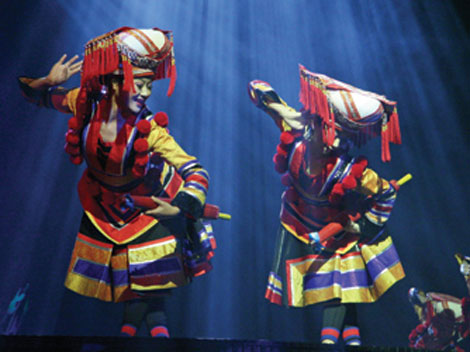
The show features folk dances from ethnic groups in Guizhou.
Shows like Wind of Colorful Guizhou touring Australia and New Zealand represent a new pattern for cultural exchanges between China and the world.
Thanks to the phenomenal Irish dance show Riverdance, people all over the world know about the music, poetry and history of Ireland.
Now, a dance show highlighting the ethnic culture of Southwest China is touring Australia and New Zealand.
Entitled Wind of Colorful Guizhou, the show features folk songs, dances and customs from more than a dozen ethnic groups - such as the Miao, Buyi and Dong - living in Guizhou province.
Born in Guizhou, the choreographer Ding Wei grew up surrounded by these melodies and dances. He has picked the best of these for the stage.
"Most ethnic groups are good at singing and dancing and to them dancing is a way of life. Many folk dances are derived from their daily lives," the 55-year-old choreographer says.
"The difficult part is to get professional dancers to imitate the movements of real villagers. To begin with, they are not as natural and relaxed as those villagers. But after they spend time living with these villagers, they begin to have an idea of their feelings," he says.
In the number Water Girls, the Miao women display both a feminine shyness, as well as a toughness toward life.
The Dong people have a saying that: "Food feeds the body, while songs feed the soul." Music has a special place in the Dong people's lives. Without a traditional written language, the Dong people have recorded much of their history and culture in their songs.
In the show, you can hear the "big song" (dage in Chinese, galao in the Dong language) of the Dong people, which is a kind of a cappella in different parts, sung by a group of singers in bright voices that have been shaped by the unique environment of the area.
The show also introduces Basha, a small Miao community that continues to live largely like it did 4,000 years ago, with animistic beliefs. It is the country's only area where civilians are permitted to own firearms.
The choreographer creates a dance to showcase the Basha people's worship of trees, equating human life cycles with those of trees. New parents plant a sapling from which their children's coffin will eventually be carved. Hoe blades are placed on the bodies to weigh down the buoyant souls, in case they float away. Another young tree is transplanted atop the burial site, to provide a marker.
It is because of the songs and dance - that go beyond language and culture barriers - that China Arts and Entertainment Group (CAEG) has chosen it for its Image China tour abroad.
We Recommend:
